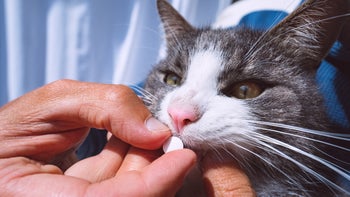
Why Do Cats Sleep So Much? It's Not Because They're Lazy
Key takeaways:
Cats can sleep up to 20 hours per day. They sleep in short bursts throughout the day, rather than settling in for a long stretch of sleep overnight.
A lot of sleep is normal for cats. They do it to conserve energy and stay sharp, in case they need to suddenly be alert to protect themselves or catch prey.
But cats can also start sleeping more if they're bored, stressed, or have an underlying health issue. If your cat's sleep patterns have changed, check in with your vet.

Cats are true masters of sleep. Whether curled up in a sunny spot or sprawled across our keyboards, our feline friends seem to spend most of their lives dozing.
But why do cats sleep so much? Is it laziness, comfort, or something deeper rooted in their biology? Their endless napping isn’t just about relaxation — it’s a survival instinct shaped by centuries of evolution.
Read on to learn why cats sleep so much.
Search and compare options
Why do cats sleep so much?
No, your cats aren't just lazy — there’s more to their sleep habits than a love for napping. Here are the key reasons cats spend so much time asleep. Note that some of these are normal and expected, while others might require a check-in with your vet.
It's how they evolved
Cats are natural predators who rely on quick, short bursts of energy to hunt. When cats stalk their prey, they crouch low to the ground and slowly sneak up on their target. When they're finally within close range, they run full speed at (and hopefully capture) their prey.
This uses a lot of energy in a short amount of time. Think of it like the high-intensity part of a HIIT (high-intensity interval training) workout. During those short bursts of intensity, you need all the energy you can get to power through the moves.
Because of this, cats instinctively want to conserve energy between "hunts." This translates to long periods of sleep during the day. While this isn't necessary for your indoor cat, who doesn't need to actually hunt to eat, domestic cats have retained this natural instinct.
They want to conserve energy
Many people think cats are nocturnal, but they're actually crepuscular. This means they're most active during dawn (the first appearance of light in the sky in the morning) and dusk (right after the sun sets but before nightfall). Evolutionarily, this is when their natural prey is most active, so they want to be awake to try to catch it.
To save energy for their hunts, cats sleep most often outside of these times. That's why your cat might be doing zoomies around the house at 6AM when you're trying to sleep.
Pain symptoms: Cats are great at hiding their pain. But if you learn to recognize these symptoms, you’ll know when your cat is hurting.
Cat not eating? Often, a change in appetite is the first sign of a health issue in cats. Here are the most common reasons cats stop eating and advice on when to get help.
Human medicines for pets: Did you know cats might be prescribed some of the same pain or anxiety medications humans take? Learn all about it here.
They have a different sleep schedule than humans
Cats are also polyphasic, which means they sleep for several short bursts throughout a 24-hour day. Unlike humans, who typically have one long stretch of sleep at night, cats sleep for short periods more often.
They're getting older
Older cats tend to sleep more. This is partly due to a natural decline in energy. But it may also be because of pain from age-related diseases. If your older cat is suddenly sleeping more, you may want to visit the vet for a checkup.
They're bored
Cats might also sleep due to boredom. Indoor cats are especially prone to boredom, because they don't get as much stimulation as outdoor cats or their wild ancestors.
To be clear, this isn't a reason to let your cat outdoors. But you do want to make sure you're actively playing with your cats and giving them other sources of stimulation, such as cat towers and catnip.
They are in pain
Pain can lead to cats sleeping more than usual. They may not be as active, and they may opt to sleep instead.
They're stressed
Cats are creatures of habit, and they can easily become stressed. If your cat is feeling overwhelmed, stressed, or anxious, they may start sleeping more than usual.
They have a health condition
Underlying health issues can also make your cat sleep more. Some common health culprits are:
Heart disease
Liver disease
Cancer
If stress or illness is the reason your cat is napping more, you'll typically see other signs, such as:
Withdrawal
Changes in appetite
More meowing than usual
If you notice your cat is sleeping more or has other new symptoms, it’s time for a veterinarian checkup.
How many hours of sleep do cats need each day?
Cats sleep 12 to 20 hours per day. How much they actually need depends on their age and health status. Kittens and senior cats need more sleep, while teenage and adult cats need less.
According to one survey, about half of cats sleep 50% to 75% of the day. The majority of other cats sleep for more than 75% of their day.
Is it normal for cats to sleep all day?
It's normal for cats to sleep for most of the day. But they shouldn't be sleeping around the clock. Your cat should be spending at least a few hours awake, roaming around the house and/or playing. If your cat isn't spending any time awake, it might be time to take them to the vet.
When should you be worried about your cat sleeping too much?
While cats naturally sleep a lot, underlying health conditions, pain, and boredom can make them sleep even more. If your cat suddenly starts sleeping more than usual, it may be a sign that something isn't quite right.
These accompanying behaviors should trigger a red flag:
They're no longer interested in playtime.
They stop eating or drinking (or eat or drink less).
They're difficult to wake or groggy and disoriented when they do wake up.
They have labored breathing, wheezing, or excessive snoring.
They have other symptoms, such as vomiting, diarrhea, weight loss, excessive thirst or changes in grooming or bathroom habits.
If anything seems off, take your cat to the veterinarian. Remember, you know your cat best. So if you're concerned, it's better to get a checkup to make sure everything is OK.
The bottom line
It's normal for cats to sleep up to 20 hours a day. While cats are domesticated now, they still have their wild evolutionary instincts, which prompt them to sleep more often to conserve energy. You don't need to be alarmed if your cat is sleeping a lot with no other changes. But if your cat has new symptoms or is sleeping more than usual, check in with your veterinarian.
Why trust our experts?



References
Castañeda, I., et al. (2023). Spatiotemporal and individual patterns of domestic cat (felis catus) hunting behaviour in France. Animals.
Henning, J., et al. (2023). Cats just want to have fun: Associations between play and welfare in domestic cats. Animal Welfare.
Niesman, I. R. (2024). Stress and the domestic cat: Have humans accidentally created an animal mimic of neurodegeneration? Frontiers in Neurology.
Parker, M., et al. (2022). Comparison of locomotor and feeding rhythms between indoor and outdoor cats living in captivity. Animals.
Scandurra, A., et al. (2023). Home sweet home: The impact of lifestyle on a cat’s approach to impossible tasks in the home environment. Animals.
Sordo, L., et al. (2020). Prevalence of disease and age-related behavioural changes in cats: Past and present. Veterinary Sciences.
Toth, L. A., et al. (2013). Animal models of sleep disorders. Comparative Medicine.

























